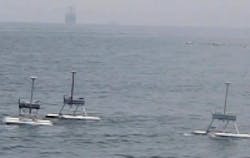Unmanned aquatic robots hunt and kill jellyfish
Unmanned aquatic robots called jellyfish elimination robotic swarm (JEROS), have been developed by the Korea Advanced Institute of Science and Technology (KAIST) for the purpose of jellyfish population control.
Swarms of jellyfish in coastal waters have led to a rising number of accidents and financial losses by the fishing industry. As a result, the KAIST team, led by Professor Hyeon Myeong, began developing an unmanned autonomous system capable of exterminating jellyfish in 2009, and has since completed successful field tests, according to a KAIST press release.
JEROS robots float on the surface of the water in two cylindrical bodies and attached motors allow them to move about the water in forward and reverse, as well as rotate 360°. An *onboard camera detects swarms of jellyfish, and geographic information system-based data is used to specify a region for extermination and a path for the task is automatically generated.
From there, JEROS navigates autonomously using a GPS receiver and an inertial navigation system. Only a leader robot requires the calculated path, and the other robots following in formation by exchanging their location information via wireless communication. Once JEROS locates the swarm, the jellyfish are removed by a submerged net and a propeller is used to pulverize them.
Field tests, which were completed in Gyeongam Masan Bay, have shown that three robots operating at 4 knots (7.2 km/h, or 4.47 mph) dispose jellyfish at a rate of about 900 kg/h. The research team will conduct further experiments in order to improve the performance in various environments and conditions. KAIST suggests that JEROS may also be utilized for other purposes, including marine patrol and prevention of oil spills, and waste removal.
View the KAIST press release.
[*Editor’s note: Camera vendor not listed.]
Also check out:
Underwater robots search for World War II pilots, aircraft
Vision-guided robots will restore coral reefs
Crabster robot will explore shipwrecks below the sea
Share your vision-related news by contacting James Carroll, Senior Web Editor, Vision Systems Design
To receive news like this in your inbox, click here.
Join our LinkedIn group | Like us on Facebook | Follow us on Twitter | Check us out on Google +
About the Author

James Carroll
Former VSD Editor James Carroll joined the team 2013. Carroll covered machine vision and imaging from numerous angles, including application stories, industry news, market updates, and new products. In addition to writing and editing articles, Carroll managed the Innovators Awards program and webcasts.
